企业并购的税务问题
企业重组并购涉及的税务问题
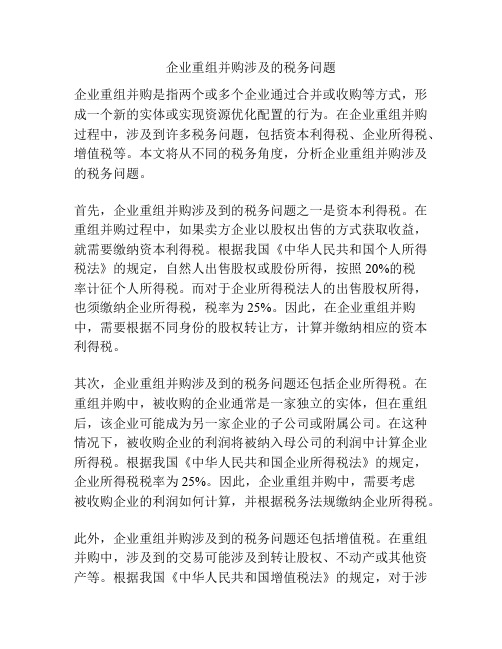
企业重组并购涉及的税务问题企业重组并购是指两个或多个企业通过合并或收购等方式,形成一个新的实体或实现资源优化配置的行为。
在企业重组并购过程中,涉及到许多税务问题,包括资本利得税、企业所得税、增值税等。
本文将从不同的税务角度,分析企业重组并购涉及的税务问题。
首先,企业重组并购涉及到的税务问题之一是资本利得税。
在重组并购过程中,如果卖方企业以股权出售的方式获取收益,就需要缴纳资本利得税。
根据我国《中华人民共和国个人所得税法》的规定,自然人出售股权或股份所得,按照20%的税率计征个人所得税。
而对于企业所得税法人的出售股权所得,也须缴纳企业所得税,税率为25%。
因此,在企业重组并购中,需要根据不同身份的股权转让方,计算并缴纳相应的资本利得税。
其次,企业重组并购涉及到的税务问题还包括企业所得税。
在重组并购中,被收购的企业通常是一家独立的实体,但在重组后,该企业可能成为另一家企业的子公司或附属公司。
在这种情况下,被收购企业的利润将被纳入母公司的利润中计算企业所得税。
根据我国《中华人民共和国企业所得税法》的规定,企业所得税税率为25%。
因此,企业重组并购中,需要考虑被收购企业的利润如何计算,并根据税务法规缴纳企业所得税。
此外,企业重组并购涉及到的税务问题还包括增值税。
在重组并购中,涉及到的交易可能涉及到转让股权、不动产或其他资产等。
根据我国《中华人民共和国增值税法》的规定,对于涉及增值税的交易,需要根据具体交易情况确定税率和计算方法。
例如,对于转让股权的交易,根据《财政部国家税务总局关于完善个人所得税政策的通知》的规定,转让股权的增值部分需要缴纳增值税。
此外,在房地产重组并购中,涉及到的不动产转让也需要缴纳增值税。
因此,在企业重组并购中,需要根据不同的资产交易类型,计算并缴纳相应的增值税。
最后,企业重组并购还可能涉及到其他税务问题,如土地增值税、印花税等。
在土地使用权或房地产等资产的转让中,可能需要缴纳土地增值税。
企业并购中“潜伏”的税务困境问题及其原因分析
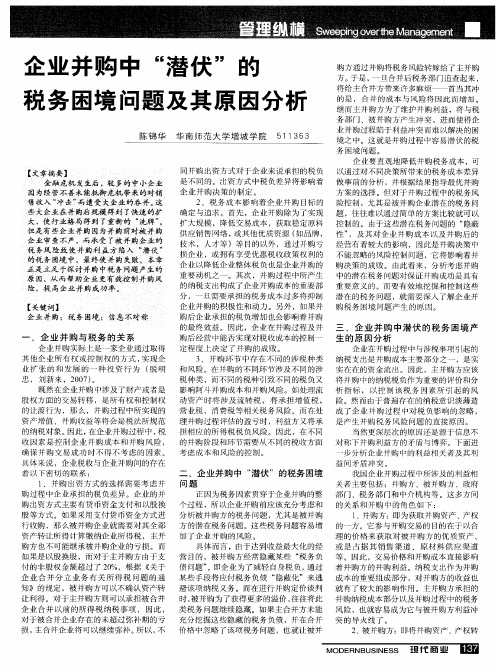
同并 购 出 资 方 式对 于企 业 来 说 承 担 的税 负 是 不 同的 。出 资方 式 中税 负差 异将 影 响着 企业并购决策 的制定 。 2 、税务成 本影响着企 业并购 目标的 确 定 与 追 求 。 首 先 ,企 业 并购 除 为 了 实 现 扩 大 规模 ,降 低交 易成 本 ,获取 稳 定 原料 供应 销售网络 , 或其 他优质 资源 ( 如品牌 , 技术 ,人 才 等 )等 目的 以 外 ,通 过 并 购 亏 损 企 业 ,或 拥 有 享 受 优 惠 税 收政 策 权 利 的 企 业 以 降低 企 业 整 体 税 负也 是 企 业 并 购 的 苇 要 动 机 之 一 。其 次 ,并购 过 程 中所 产 生 的纳 税 支 出构 成 了企 业 并购 成 本 的重 要 部 分 ,一 旦 需要 承 担 的 税 务 成 本 过 多 将 抑 制 企 业 并购 的积 极 性 和 动 力 。 另 外 ,如 果 并 购后企业承担 的税负增 加也会影响着并购 的最终效益 。因此 ,企业在并购过程及并 购 后 经 营 中能 否 实 现 对 税 收 成 本 的 控 制 一 定 程 度 上 决 定 _并 购 的 成 败 。 『 3 、并 购 环 节 中 存 在 不 同 的 涉 税 种 类 和 风 险 。在 并 购 的 不 同环 节 涉 及 不 同 的涉 税 种 类 ,而 不 同 的 税 种 引 致 不 同的 税 负 又 影 响 阿 斗 并 购 成 本 和 并 购 风 险 。如 处 理 流 动 资产 时将涉及 流转税 ,将承 担增值税 , 营 业 税 ,消 费 税 等 相 关 税 务 风 险 。而 在 处 理 并 购 过 程 评 估 的 盈 亏 时 ,利 益 方 又 将 承 担相应 的所得税税 负风险。因此 ,在不 同 的 并 购 阶 段 和 环 节 需 要 从 不 同的 税 收 方 面 考虑成本 和风险的控制 。
企业重组并购的税务问题税屋财税政策法规(可编辑)
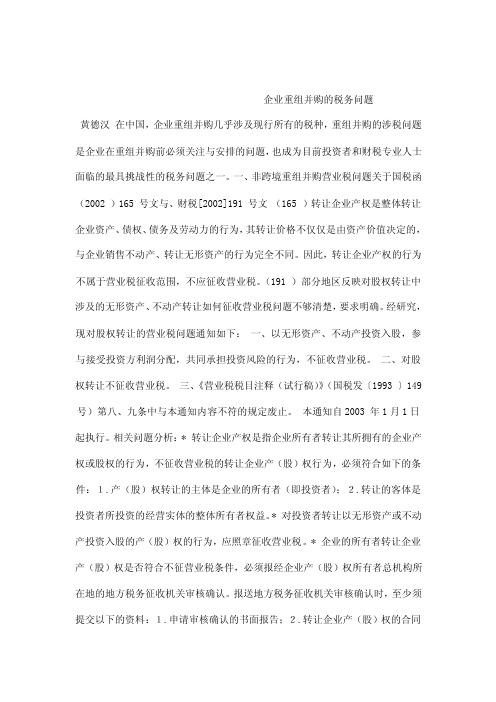
企业重组并购的税务问题黄德汉在中国,企业重组并购几乎涉及现行所有的税种,重组并购的涉税问题是企业在重组并购前必须关注与安排的问题,也成为目前投资者和财税专业人士面临的最具挑战性的税务问题之一。
一、非跨境重组并购营业税问题关于国税函(2002 )165 号文与、财税[2002]191 号文(165 )转让企业产权是整体转让企业资产、债权、债务及劳动力的行为,其转让价格不仅仅是由资产价值决定的,与企业销售不动产、转让无形资产的行为完全不同。
因此,转让企业产权的行为不属于营业税征收范围,不应征收营业税。
(191 )部分地区反映对股权转让中涉及的无形资产、不动产转让如何征收营业税问题不够清楚,要求明确。
经研究,现对股权转让的营业税问题通知如下:一、以无形资产、不动产投资入股,参与接受投资方利润分配,共同承担投资风险的行为,不征收营业税。
二、对股权转让不征收营业税。
三、《营业税税目注释(试行稿)》(国税发〔1993 〕149 号)第八、九条中与本通知内容不符的规定废止。
本通知自2003 年1月1日起执行。
相关问题分析:* 转让企业产权是指企业所有者转让其所拥有的企业产权或股权的行为,不征收营业税的转让企业产(股)权行为,必须符合如下的条件:1.产(股)权转让的主体是企业的所有者(即投资者);2.转让的客体是投资者所投资的经营实体的整体所有者权益。
* 对投资者转让以无形资产或不动产投资入股的产(股)权的行为,应照章征收营业税。
* 企业的所有者转让企业产(股)权是否符合不征营业税条件,必须报经企业产(股)权所有者总机构所在地的地方税务征收机关审核确认。
报送地方税务征收机关审核确认时,至少须提交以下的资料:1.申请审核确认的书面报告;2.转让企业产(股)权的合同文件复印件;3.企业产(股)权来源或性质的证明文件复印件。
* 是否开具发票问题。
动产的增值税问题关于国税函〔2002 〕420 号文转让企业全部产权是整体转让企业资产、债权、债务及劳动力的行为,因此,转让企业全部产权涉及的应税货物的转让,不属于增值税的征税范围,不征收增值税。
基于企业并购重组中的税务风险控制分析

基于企业并购重组中的税务风险控制分析税务风险控制是企业并购重组过程中必不可少的环节,因为税务风险可能会对企业的长期发展产生负面影响。
本文将从税务风险控制的角度分析企业并购重组中的税务风险,并提出相关的措施以降低税务风险。
首先,税务风险主要表现在企业是否遵守税收法律法规和税务规定,如企业是否存在未申报或漏报税款、未及时缴纳税款、未按规定申报税前扣除、涉税事项不合理导致的税务争议等。
这些问题可能会导致企业受到税务管理部门的处罚,进而影响企业声誉和经济利益。
1. 并购重组过程中有可能发生企业重组报告书、交易协议等文书的造假问题,如果被税务管理部门发现,会对企业造成极大的损害。
2. 并购重组涉及到人员调整、财务重组、资产重组等方面,这些涉及到的税务问题十分复杂,如果管理不当很容易造成税务风险。
3. 如果并购重组后未能及时完成纳税申报和缴税工作,或者未正确计算税费,会产生罚款和滞纳金等问题。
针对以上风险,企业应采取以下措施:1. 在企业并购重组前,应对税务风险进行细致的分析,针对可能存在的风险,采取相应措施进行减轻和消除。
2. 对于并购重组过程中需要的各种文件,如企业重组报告书、交易协议等文书,应严格遵守税务法规和规定,确保文件内容真实、准确。
3. 涉及到人员调整、财务重组、资产重组等方面的税务问题,应提前咨询专业税务人员,并严格按照相关规定进行操作。
4. 并购重组后应及时向税务管理部门报告税务信息,并按时缴纳相关税费和滞纳金。
5. 如果发生税务纠纷,应及时向专业机构寻求帮助,化解风险。
综上所述,税务风险控制在企业并购重组中非常重要,只有充分了解税务法规和规定,并按照规定进行操作,才能更好地减轻税务风险,保障企业健康发展。
企业并购过程中的税务问题
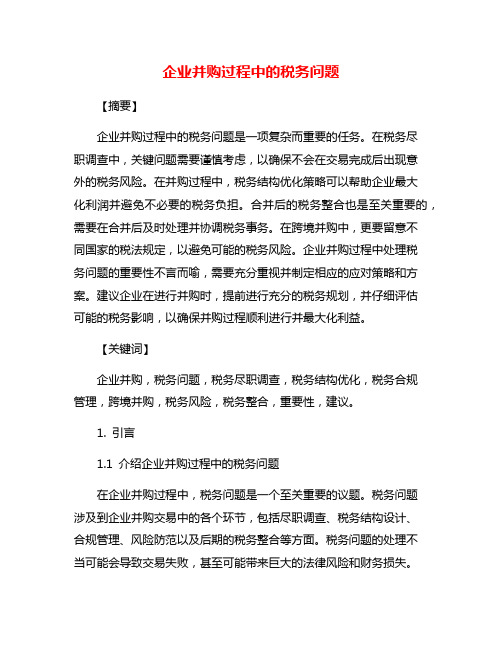
企业并购过程中的税务问题【摘要】企业并购过程中的税务问题是一项复杂而重要的任务。
在税务尽职调查中,关键问题需要谨慎考虑,以确保不会在交易完成后出现意外的税务风险。
在并购过程中,税务结构优化策略可以帮助企业最大化利润并避免不必要的税务负担。
合并后的税务整合也是至关重要的,需要在合并后及时处理并协调税务事务。
在跨境并购中,更要留意不同国家的税法规定,以避免可能的税务风险。
企业并购过程中处理税务问题的重要性不言而喻,需要充分重视并制定相应的应对策略和方案。
建议企业在进行并购时,提前进行充分的税务规划,并仔细评估可能的税务影响,以确保并购过程顺利进行并最大化利益。
【关键词】企业并购,税务问题,税务尽职调查,税务结构优化,税务合规管理,跨境并购,税务风险,税务整合,重要性,建议。
1. 引言1.1 介绍企业并购过程中的税务问题在企业并购过程中,税务问题是一个至关重要的议题。
税务问题涉及到企业并购交易中的各个环节,包括尽职调查、税务结构设计、合规管理、风险防范以及后期的税务整合等方面。
税务问题的处理不当可能会导致交易失败,甚至可能带来巨大的法律风险和财务损失。
在进行企业并购交易时,税务尽职调查是至关重要的一个环节。
通过对目标公司的税务情况进行全面的审查和评估,可以帮助买方更好地了解目标公司的税务风险和潜在的税务优化空间。
税务结构优化策略的制定也是企业并购过程中的重要环节,通过合理的税务结构设计,可以最大程度地降低税务成本,提升交易价值。
在跨境并购中,税务问题更是复杂多样。
不同国家的税法差异导致了跨境并购交易中的税务风险增加,需要买卖双方谨慎应对。
在并购交易完成后,税务整合也是企业必须面对的挑战之一,如何合理统一各方税务政策,并确保税务合规,对企业整体业务的发展至关重要。
2. 正文2.1 税务尽职调查中的关键问题1. 税收合规情况:检查目标公司过去几年的税收申报记录和缴税情况,确保其合规性,避免潜在的税务风险。
基于企业并购重组中的税务风险控制分析

基于企业并购重组中的税务风险控制分析随着全球化和市场经济的发展,企业并购重组已经成为了当今商业世界中不可或缺的一部分。
通过企业并购重组,企业可以快速扩大规模,获取资源和技术,提升市场竞争力,实现战略转型等目的。
在进行并购重组过程中,企业也面临着诸多税务风险,包括税收合规风险、税务风险管理和税务风险规避等问题。
本文将就基于企业并购重组中的税务风险进行分析,并提出相应的风险控制措施。
一、税务风险分析1.税收合规风险在企业并购重组中,税收合规风险是一项极为重要的问题。
企业在并购重组中涉及到众多的税收问题,包括资产重组、股权转让、企业重组等。
一旦在这些过程中未能合规纳税,就会导致税务管理部门的调查和处罚,从而增加企业的经营成本,甚至影响到企业的正常经营。
企业必须加强对税收合规风险的认识和防范,确保在并购重组中合法合规纳税。
2.税务风险管理在企业并购重组中,税务风险管理也是一个至关重要的问题。
企业必须对并购重组前后的税务情况进行全面的分析和评估,确保在交易完成后不会出现不利的税务后果。
企业还需制定相应的税务筹划方案,合理规避税务风险,降低税务成本,保护企业的利益。
在企业并购重组中,税务风险规避也是一个需要重视的问题。
企业在并购重组过程中需采取一系列的措施,规避潜在的税务风险。
这包括避免潜在的法律风险、规避潜在的税收争议以及保护企业交易的合法性。
只有在避免潜在的税务风险的情况下,企业才能顺利完成并购重组过程。
二、税务风险控制措施1.加强税务尽职调查在进行企业并购重组前,企业必须进行全面的税务尽职调查,了解目标企业的税务状况,发现潜在的税务风险,评估潜在的税务影响,并据此进行风险评估和规避。
只有在对目标企业的税务情况有充分了解的情况下,企业才能有效地规避税务风险。
2.合理规划税务结构在进行企业并购重组时,企业需要合理规划税务结构,避免因税务问题而导致交易不利或者产生不必要的税务成本。
企业应该充分了解税收政策,利用适当的税收优惠政策和税收筹划手段,有效规避税务风险,降低税务成本。
企业并购中的税务风险分析及控制对策
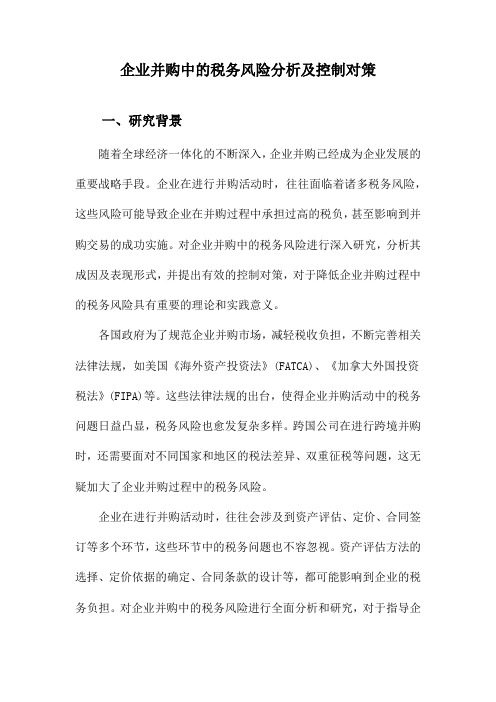
企业并购中的税务风险分析及控制对策一、研究背景随着全球经济一体化的不断深入,企业并购已经成为企业发展的重要战略手段。
企业在进行并购活动时,往往面临着诸多税务风险,这些风险可能导致企业在并购过程中承担过高的税负,甚至影响到并购交易的成功实施。
对企业并购中的税务风险进行深入研究,分析其成因及表现形式,并提出有效的控制对策,对于降低企业并购过程中的税务风险具有重要的理论和实践意义。
各国政府为了规范企业并购市场,减轻税收负担,不断完善相关法律法规,如美国《海外资产投资法》(FATCA)、《加拿大外国投资税法》(FIPA)等。
这些法律法规的出台,使得企业并购活动中的税务问题日益凸显,税务风险也愈发复杂多样。
跨国公司在进行跨境并购时,还需要面对不同国家和地区的税法差异、双重征税等问题,这无疑加大了企业并购过程中的税务风险。
企业在进行并购活动时,往往会涉及到资产评估、定价、合同签订等多个环节,这些环节中的税务问题也不容忽视。
资产评估方法的选择、定价依据的确定、合同条款的设计等,都可能影响到企业的税务负担。
对企业并购中的税务风险进行全面分析和研究,对于指导企业合理规避税务风险,降低并购成本具有重要意义。
1. 企业并购的定义和特点企业并购是指一个企业通过购买另一个企业的股权或资产,实现对后者的控制权,从而实现企业规模、技术、市场等方面的扩张。
企业并购是一种重要的市场竞争手段,对于企业的发展具有重要意义。
企业在进行并购活动时,往往会面临诸多税务风险。
本文将对这些风险进行分析,并提出相应的控制对策,以帮助企业在并购过程中有效应对税务风险。
复杂性:企业并购涉及的法律、财务、税收等多个领域,具有较高的复杂性。
企业在进行并购时,需要充分了解相关法律法规,确保合规操作。
不确定性:企业并购过程中,各种不确定因素较多,如政策变动、市场环境变化等,这些因素可能对企业并购产生影响,增加税务风险。
信息不对称:企业并购双方在信息披露、交易定价等方面可能存在信息不对称现象,导致税务风险的产生。
并购重组中的税务案例
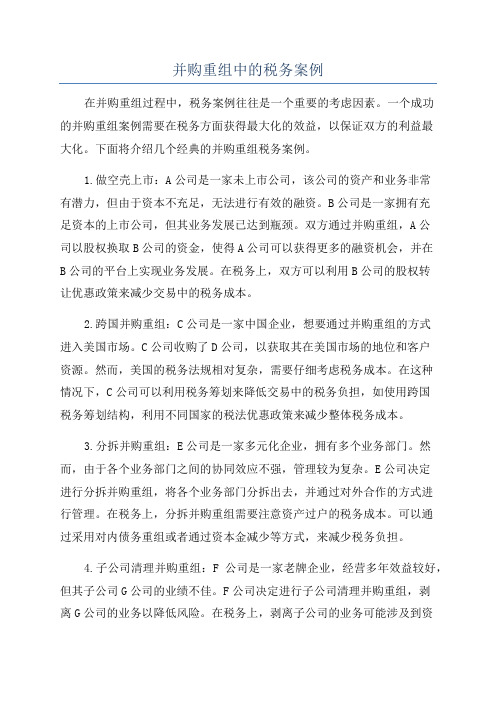
并购重组中的税务案例在并购重组过程中,税务案例往往是一个重要的考虑因素。
一个成功的并购重组案例需要在税务方面获得最大化的效益,以保证双方的利益最大化。
下面将介绍几个经典的并购重组税务案例。
1.做空壳上市:A公司是一家未上市公司,该公司的资产和业务非常有潜力,但由于资本不充足,无法进行有效的融资。
B公司是一家拥有充足资本的上市公司,但其业务发展已达到瓶颈。
双方通过并购重组,A公司以股权换取B公司的资金,使得A公司可以获得更多的融资机会,并在B公司的平台上实现业务发展。
在税务上,双方可以利用B公司的股权转让优惠政策来减少交易中的税务成本。
2.跨国并购重组:C公司是一家中国企业,想要通过并购重组的方式进入美国市场。
C公司收购了D公司,以获取其在美国市场的地位和客户资源。
然而,美国的税务法规相对复杂,需要仔细考虑税务成本。
在这种情况下,C公司可以利用税务筹划来降低交易中的税务负担,如使用跨国税务筹划结构,利用不同国家的税法优惠政策来减少整体税务成本。
3.分拆并购重组:E公司是一家多元化企业,拥有多个业务部门。
然而,由于各个业务部门之间的协同效应不强,管理较为复杂。
E公司决定进行分拆并购重组,将各个业务部门分拆出去,并通过对外合作的方式进行管理。
在税务上,分拆并购重组需要注意资产过户的税务成本。
可以通过采用对内债务重组或者通过资本金减少等方式,来减少税务负担。
4.子公司清理并购重组:F公司是一家老牌企业,经营多年效益较好,但其子公司G公司的业绩不佳。
F公司决定进行子公司清理并购重组,剥离G公司的业务以降低风险。
在税务上,剥离子公司的业务可能涉及到资产转让和业务清算等事项。
在税务筹划上,可以通过采用资产置换的方式,减少资产转让所带来的税务负担。
以上是一些经典的并购重组税务案例,这些案例充分体现了税务在并购重组中的重要性。
在面对并购重组时,企业需要从税务方面进行充分的规划和筹划,以确保最大程度上减少税务负担,实现双方的利益最大化。
- 1、下载文档前请自行甄别文档内容的完整性,平台不提供额外的编辑、内容补充、找答案等附加服务。
- 2、"仅部分预览"的文档,不可在线预览部分如存在完整性等问题,可反馈申请退款(可完整预览的文档不适用该条件!)。
- 3、如文档侵犯您的权益,请联系客服反馈,我们会尽快为您处理(人工客服工作时间:9:00-18:30)。
Updated September, 2007© 2007, Davis Malm & D'Agostine, P.C.Tax Aspects of Corporate Mergers and AcquisitionsWilliam F. Griffin, Jr.Avi M. LevDavis, Malm & D’Agostine, P.C.The following outline is intended to acquaint the reader with some of the more important income tax aspects of merger and acquisition transactions. As with any summary, most of the general statements which follow are subject to numerous exceptions and qualifications. For example, the tax consequences of a transaction may vary significantly if one or more of the parties is a member of a consolidated group, an S corporation, a foreign corporation, or a tax-exempt organization. You should rely on a more comprehensive treatise for complete and detailed information on this subject.1As a matter of terminology, the parties to the transactions described in this outline are identified as follows:“P”means the purchasing or acquiring corporation;“S”means a wholly-owned corporate subsidiary of P; and“T”means the acquired corporation, or “target”.I.TAXABLE SALE OF STOCK1.1.In this transaction, P purchases all of T’s stock directly from T’s shareholders, in consideration of cash, notes, or some other taxable consideration (or a combination thereof). Asa result, T becomes a wholly-owned subsidiary of P.1 See generally, Ginsburg & Levin, Mergers, Acquisitions, and Buyouts(2006); Bittker & Eustice, Federal Income Taxation of Corporations and Shareholders(7th ed. 2002); Freund, Anatomy of a Merger(1975); Philips & Rothman, 770-3rd T.M., Structuring Corporation Acquisitions -Tax Aspects(2004); Kling & Nugent-Simon, Negotiated Acquisitions of Companies, Subsidiaries and Divisions(2002).1.2.T’s shareholders recognize gain or loss on the sale of their stock, usually capital gain or loss, measured by the difference between the basis in the stock and the purchase price. Generally, individuals are taxed at a 15% rate on capital gains under current federal tax law.1.3.T recognizes no gain or loss on the transaction and its basis in its assets remains unchanged.1.4.T’s corporate tax attributes (net operating loss carryovers,etc.) remain unchanged, but may be limited as discussed in Section XIII infra.1.5.P takes a new tax basis in the T stock purchased from the T shareholders equal to the purchase price paid by P therefor.1.6 A liquidation or merger of T into P following a taxable purchase of 80% or more of T's stock will ordinarily be tax free. Rev. Rul. 90-95, 1990-2 C.B. 67.II.TAXABLE SALE OF ASSETS2.1.In this transaction, T transfers substantially all of its assets to P, which may assume none, some, or all of T’s liabilities, in consideration of the payment of cash, notes, or some other taxable consideration (or a combination thereof). After the closing, P becomes the new owner of T’s assets and any assumed liabilities. T remains in existence immediately after the closing, owning the consideration received for the sale of its assets as well as any assets or liabilities excluded from the sale. T may continue in existence or may be liquidated, in which case its net assets (including the proceeds of sale) are distributed to the T shareholders.2.2.T recognizes gain or loss on the sale of its assets, measured by the difference between its basis in those assets and the purchase price (including any liabilities assumed). This gain or loss may be capital or ordinary, depending on the nature of the assets sold. Recapture of depreciation will give rise to ordinary income. (§§1245 and 1250). Sales of §1231 assets (basically depreciable property used in a trade or business and held for more than one year) will give rise to capital gain or ordinary loss.2.3.T’s tax attributes do not carry over to P. However, T’s net operating losses will be available to offset gain to T recognized on the sale.2.4.P takes a new basis in T’s assets equal to the purchase price for those assets (including assumed liabilities).2.5.The purchase price for T’s assets is allocated among those assets in accordance with§1060. See Section V infra.2.6.T’s shareholders do not recognize gain or loss unless T is liquidated.2.7.If T is liquidated, T’s shareholders will recognize gain or loss measured by the difference between their tax basis in their stock and the value of the property distributed to them. Thus, there is a “double tax”on a liquidation: a corporate level tax on the sale of assets and a shareholder level tax on the distribution of sale proceeds.III.TAXABLE MERGERS3.1. A merger is the combination of two corporations into one in accordance with state corporation law. Taxable merger transactions can take three basic forms:(a) a direct merger of T into P, with P the survivor. As a result of thistransaction, P succeeds to all of T’s assets and liabilities and T’s shareholders receivecash, notes, or other taxable consideration (or a combination thereof).(b) a forward triangular merger of T into S (a wholly-owned corporatesubsidiary of P), with S the survivor. As a result of this transaction, S succeeds to all of T’s assets and liabilities and T’s shareholders receive cash, notes, or other taxableconsideration (or a combination thereof).(c) a reverse triangular merger of S into T, with T the survivor. As a result ofthis transaction, T becomes a wholly-owned subsidiary of P and T’s shareholders receive cash, notes, or other taxable consideration (or a combination thereof).3.2. A direct taxable merger will be treated as a taxable sale of assets by T to P, followed by a liquidation of T. Rev. Rul. 69-6, 1969-1 C.B. 104. The tax consequences to the parties will be as described under “Taxable Sale of Assets”supra.3.3. A forward triangular merger will be treated as a taxable sale of assets by T to S, followed by the liquidation of T. The tax consequences will be as described under “Taxable Sale of Assets”supra.3.4. A reverse triangular merger, on the other hand, will be treated as a sale of stockby T’s shareholders to P. The tax consequences to the parties will be as described under “Taxable Sale of Stock”supra.IV.DEEMED ASSET SALES UNDER SECTION 3384.1.If P purchases the stock of T and makes an election under §338, the transaction is treated as a sale of assets by T to itself at fair market value. (§338(a)).4.2.As a result, T recognizes gain or loss on the deemed sale of assets. Since P is the new shareholder of T, P (and not T’s former shareholders) bears the economic detriment of the additional taxes due by T in the year of purchase.24.3.T will acquire a new basis in its assets equal to the purchase price plus T’s liabilities, including any tax liabilities resulting from the deemed sale.4.4.T’s tax attributes do not continue, although net operating losses may be applied against any gain on the deemed sale.4.5.T’s shareholders are not affected by the election.4.6.The benefit of a §338 election (a stepped-up basis in T’s assets) comes at the cost of immediate realization of tax on the appreciation in value of those assets. Since the principal benefit of the step-up in basis is only realized over time through depreciation and amortization, there is rarely an advantage to making a §338 election.V.ALLOCATION RULES FOR ASSET TRANSACTIONS5.1.In an asset sale transaction, the allocation of the aggregate purchase price among T’s assets is of great importance for both T and P. T would prefer to allocate as much of the price as possible to long-term capital gain items and as little as possible to ordinary income items, recapture items and short-term capital gain items. P, on the other hand, would prefer to allocate as much as possible to inventory or items recoverable by depreciation or amortization, and as little as possible to non-depreciable assets, such as land and stock.5.2.Two statutory provisions greatly reduce the parties’ flexibility in allocating purchase price: the asset allocation rules of §1060and the rules for amortization of intangibles under §197.2Section 338(h)(10) provides a special election pursuant to which a sale of stock of a corporation which is a member of an consolidated group is treated as though it were an asset sale followed by a liquidation of T. Unlike an ordinary 338 election, the deemed sale takes place while T is still a member of the affiliated group and the economic consequences of the tax on the appreciated value of T’s assets falls on T’s shareholder, rather than on P. The benefit of this election has been extended by regulation to S corporations as well. Treas. Reg. §1.338(h)(10) -1(c)(1).Section 10605.3.Section 1060 prescribes the so-called “residual method”for the allocation of purchase price in a taxable asset acquisition.3Under that method, the amount of the purchase price (including assumed liabilities) is allocated in accordance with the following priorities:(a)First, to cash and demand deposits (Class I assets);(b)Second, to actively traded personal property(such as securities), foreigncurrency, and certificates of deposit (Class II assets), in an amount equal to their fairmarket value;(c)Third, to assets that the taxpayer marks to market for income tax purposes(Class III assets),in like manner;(d)Fourth, to stock in trade or inventory of the taxpayer (Class IV assets);(f)Fifth, to all other assets not included in the other classes (Class V assets);(g)Sixth, to all Section 197 assets except goodwill and going concern value(Class VI assets);and(h)the balance to intangible assets in the nature of goodwill and goingconcern value (Class VII assets).5.4.Form8594 must be filed by each party to the transaction with its tax return for the year of sale.Section 1975.5.Under §197, an amortization deduction is allowed for the capitalized cost of certain types of purchased intangibles, including goodwill, going concern value, workforce in place, books and records, customer lists, licenses, permits, franchises and trademarks. A §197 intangible must be amortized over a 15-year period.5.6.Section 197 reduces the importance to P of limiting the allocation of purchase price to goodwill and going concern value. In fact, P would now prefer to allocate more of the purchase price to goodwill rather than to depreciable assets with recovery periods greater than 15 years, such as real property.3Section 1060(a) adopts the price allocation regulations under §338(b)(5). Treas. Reg.,§§1.338-6(b) and 1.1060-1(c), T.D. 8940, 66 Fed. Reg. 9925 (Feb. 13, 2001).VI.COVENANTS NOT TO COMPETE AND CONSULTING AGREEMENTS6.1.Purchasers of corporate assets or stock frequently attempt to allocate a portion of the consideration for the sale of the business to covenants not to compete, consulting agreements, or similar compensatory arrangements for T’s shareholders.6.2.The purchasers’ motivation is often to convert a payment for nondepreciable stock (in a stock deal) or for assets depreciable over a long recovery period (in an asset deal) into a currently deductible payment. The seller may resist this allocation since those payments constitute ordinary income rather than capital gain.6.3.Section 197, discussed under “Allocation Rules for Asset Transactions”supra, requires that non-competition payments be capitalized and amortized over a 15 year term. This period is considerably longer than the term of most non-compete agreements, which defined the amortization period under prior law.6.4.To the extent that payments by P or T for consulting services are reasonable in amount, they are deductible over the life of the agreement. If such payments are unreasonable in amount, they will be recharacterized as (i)part of the purchase price of the acquired stock (in a stock deal) or (ii)part of the purchase price of the acquired assets (in an assets deal). In the latter case, the amount so recharacterized may be allocated to depreciable or nondepreciable assets, including goodwill and covenants not to compete amortizable under §197.VII.INSTALLMENT SALES7.1.Under §453, a taxpayer who sells property and receives payment after the close of the taxable year of sale may report gain or loss under the installment method. The installment method is automatic, unless the taxpayer opts out of the method by electing to recognize the entire gain or loss in the year of sale.7.2.Under the installment method, a pro rata portion of the gain from a deferred payment transaction is recognized over the payment period. Example: A sells his stock in T (a closely-held corporation) to P for a $500,000 note payable as to principal in five annual installments of $100,000. A’s basis in the stock is $200,000; he therefore has a $300,000 gain.A will report one-fifth of the gain ($60,000) each year.7.3.The balance of the deferred gain or loss must be recognized upon the sale or other disposition of the installment obligation. Example: Assume the facts of the previous example. After receiving the first $100,000 installment of principal, A sells the promissory note for $400,000. A will recognize the deferred $240,000 in gain ($60,000 times 4) in the year of disposition of the note. (§453B). A foreclosure of a security interest in stock or other personal property is treated as a sale or disposition of the installment obligation, even if the seller “takes back”the property in satisfaction of the obligation.7.4.Generally, where a portion of the purchase price is contigent (for example, on the future success of the business sold), the seller must assume that the maximum proceeds will accrue, and allocate basis pro rata accordingly across tax years.This usually bunches gains in early years and so results in minimum deferral.7.5.Installment sale treatment is not available for dealers in property or for inventory items. (§453(b)).7.6.Installment sale treatment is not available if the installment obligation received is payable on demand or is a readily marketable security. (§453(f)(4)).7.7.The installment method may be used by a selling shareholder of corporate stock, unless the stock is traded on an established securities market. (§452(k)).7.8.The installment method may be used by T in a taxable asset sale, provided that T is a cash basis taxpayer and does not liquidate. However, installment sale treatment will not apply to the sale of inventory or marketable securities or to the extent of depreciation recapture. (§453(b)(2); §453(l)(1); §453 (k)(2);and §453 (i)).7.9.If T sells its assets for an installment obligation and then liquidates, it will recognize gain in the same manner as if it had elected out of the installment method. However, T’s cash basis shareholders may report their gain on the liquidation on the installment method if the liquidation occurs within 12 months. (§453(h)). This is an exception to the general rule that receipt of an obligation of a person other than the purchaser does not qualify for installment sale treatment.7.10.Special rules apply to installment sales to related parties who dispose of the property within two years following the sale. (§453(e)).7.11.Section 453A requires the recognition of income on the pledge of certain installment obligations.VIII.INTEREST ON ACQUISITION INDEBTEDNESS8.1.Section 279 limits the interest deductions on “corporate acquisition indebtedness”in excess of $5,000,000 per year. This amount is reduced by interest on certain other acquisition debt incurred after 1967.8.2.“Corporate acquisition indebtedness”is convertible subordinated debt incurred for the purpose of an acquisition, if the issuing corporation’s debt-to-equity ratio exceeds 2:1 or if its average earnings for the past three years are less than three times the annual interest paid or incurred.8.3Section 163 denies the interest deduction for payments on an “applicable high yield debt obligation”(AHYDO),which generally is a high-interest debt with greater than a 5-year maturity generating “significant original issue discount;”this occurs usually where payments in kind (PIK) are allowed to defer cash payments of interests. Section 163 also denies the deduction for certain types of convertible debt, i.e., debt payable in equity of the issuer.IX.TAX-FREE REORGANIZATIONS9.1.Section 368 describes certain transactions which qualify as tax-free “reorganizations.”These include the following common acquisition techniques:(a) a statutory merger, or “A”reorganization (§368(a)(1)(A)), including:(i) a forward triangular merger (§368(a)(2)(D)); and(ii) a reverse triangular merger (§368(a)(2)(E)).(b)an acquisition of stock for voting stock, or “B”reorganization (§368(a)(1)(B));and(c)an acquisition of assets for voting stock, or “C”reorganization (§368(a)(1)(C)).9.2.Section 368 contains specific definitional requirements which must be met in order for a transaction to qualify as a “reorganization”.9.3Generally, a corporation may merge into a “disregarded entity” (single-member limited liability company, or a qualified subsidiary of a REITs or S corporation) under specified circumstances and still qualify as a tax-free “A”or “C”reorganization.Treas. Reg., §1.368-2.9.4In addition to these statutory requirements, the courts have imposed several judicially-created requirements: continuity of interest, continuity of business enterprise and business purpose.Continuity of Interest9.3.The continuity of interest doctrine requires that in a reorganization, the shareholders of the acquired corporation retain some significant equity participation in the combined enterprise after the closing of the transaction. Treas. Reg. §1.368-2(a), codifying a line of U.S. Supreme Court cases commencing with Pinellas Ice & Cold Storage Co. v. Comm’r, 287 U.S. 462 (1933).9.4.The continuity of interest doctrine deals primarily with the type of consideration received by the T shareholders. An acquisition in which the T shareholders receive only cash or debt obligations of T will not satisfy the continuity of interest requirement; the T shareholders must receive some kind of equity security in P.9.5.Moreover, a “substantial portion”of the consideration received by the T shareholders must be equity securities. Helvering v. Minnesota Tea Co., 296 U.S. 378 (1935). The IRS requires for tax ruling purposes that a least 50% of the total value of T’s equity securities be acquired in consideration of equity securities of P. Rev. Proc. 77-37, 1977-2 C.B. 568, §3.02. However, the IRS issued regulations in September,2005 include an example in which only40% of the value of the target was for consideration in the form of equity, and the COI requirement was deemed to be satisfied.Treas. Regs.,§1.368-1(e)(2)(v), Example1. In contrast, the regulations clearly indicate that 15% continuity is insufficient. Treas. Regs. §1.368-1(e)(7), Ex. 6. These more recent regulations seem more in line with the traditional case law.49.6.Sales of P stock immediately after the acquisition could, under the step transaction doctrine, be deemed the receipt of cash by the T shareholders. For example, assume that immediately following a statutory merger of T into P, T’s sole shareholder, by prearrangement, sells all of the P stock acquired by him in the merger. Under the regulations, dispositions of P stock following the merger (even if prearranged) do not adversely affect continuity of interest unless the purchaser of the stock is P or a related person. Treas. Reg.§1.368-1(e), Example 1(i).9.7.Likewise, sales of P stock immediately prior to the reorganization do not adversely affect continuity of interest unless the consideration for the stock comes from P or a related person. Treas. Reg. §1.368-1(e), Example 1(ii).9.8.On the other hand, the IRS regards redemptions by T of its stock in connection with a reorganization as cash received in the reorganization, whether the source of funds is T or P. Regulations also provide that continuity of interest is compromised by an “extraordinary distribution”to shareholders made by T prior to a reorganization. Treas. Reg. §1.368-1(e)(1); see also Treas. Reg., §1.368-1(e)(7), Example 4.9.9Where target shareholders receive both money and stock in the acquiring corporation for their interest in target, valuations are made as of the last business day before there is a binding contract (or tender offer) to effect the reorganization. This “signing date rule”is to allay concerns that otherwise eligible reorganizations could fail because of a decline in the acquirer’s stock value between offer and closing. Temp.Reg. §1.368-1T(e)(2); T.D. 9316 (March 19, 2007).9.10Neither the COI requirements nor the COBE requirements (discussed below) apply to “E”and “F”reorganizations. T.D. 9182 (Feb. 25, 2005).4See John A. Nelson Co. v. Helvering, 296 U.S. 374 (1935) (37.5% continuity found acceptable) and Miller v. Comm'r., 84 F.2d 415 (6th Cir. 1936) (25% continuity found acceptable). As discussed infra, the statutory requirements for B and C reorganizations mandate that those transactions be “solely for voting stock;” this statutory continuity of interest requirement obviously supersedes the more generous judicial limitation.Continuity of Business Enterprise9.11.The continuity of business enterprise doctrine requires that the acquiring corporation continue to carry on a line of the acquired corporation’s business or use a significant portion of the assets of the acquired corporation in another business. Treas. Reg. §1.368-1(d)(2).9.12.For example, if immediately following a merger of T into P, P terminates all of T’s business operations and disposes of all of T’s assets, the transaction will not qualify as a tax-free reorganization. However, if P terminates all of T’s business operations but uses T’s assets in a different line of business, the transaction will satisfy the continuity of business enterprise doctrine.9.13.The fact that P “drops down”T’s assets into a subsidiary does not adversely affect the continuity of T’s business enterprise. Treas. Reg., §§1.368-1(d)(4) and (d)(5).9.14.Post-acquisition transfers of assets among members of a “qualified group”of corporations or to partnerships in which members of the qualified group have a significant interest or “active and substantial”management functions, will not violate the continuity of business enterprise rule. Treas. Reg.§1.368-1(d)(4).Business Purpose9.15.The business purpose doctrine states that a transaction will qualify as a reorganization only if it is undertaken for reasons germane to the business of a corporation which is a party to the reorganization. Treas. Reg. §1.368-2(g).9.16.The purpose of this requirement is apparently to exclude transactions entered into exclusively for tax purposes without a non-tax business rationale. As such, it reflects a codification of the famous doctrine of Gregory v. Helvering, 293 U.S. 465 (1935), that in tax law substance will control over form.X.TAX-FREE MERGERS10.1.An “A”reorganization is defined in §368(a)(1)(A) as “a statutory merger or consolidation.”An A reorganization is the most flexible of the three basic forms of reorganization.10.2.An A reorganization is the only form which permits a significant amount of cash, notes or other taxable consideration (“boot”) to be paid to the T shareholders without disqualifying the transaction as a tax-free reorganization.10.3.For example, if P acquires T in a statutory merger under which P pays T’s shareholders up to 50% in cash or other taxable “boot”in addition to P equity securities, the transaction will qualify as a tax-free A reorganization (although T’s shareholders may recognize taxable gain on the receipt of boot, as discussed below).10.4.In an A reorganization, T’s shareholders do not recognize gain except with respect to the receipt of boot.510.5.In contrast, no loss is recognized on the exchange of T stock, unless the shareholder receives no stock or securities of P, but only boot. (§356(c)).10.6.The basis of the P stock in the hands of the former T shareholder will be equal to his basis in the T stock surrendered, decreased by the amount of boot received and increased by the amount of gain recognized. (§358(a)).10.7.Generally speaking, T will not recognize any gain or loss on either the transfer of its assets to P, or the distribution to its shareholders of the proceeds of that transfer. (§361). This is true even though T may be deemed to have transferred assets to P for consideration which includes boot taxable to its shareholders.10.8.P’s basis in the assets acquired in the merger transaction will be equal to T’s basis in those assets, increased by the amount of gain (if any) recognized by T as a result of the transaction. (§362(b)).10.9.T’s tax attributes will carry over to P, subject to the limitations discussed in Section XIII infra.10.10.Warrants are generally not treated as boot in a tax-free reorganization. Treas. Reg. §354-(e); Rev. Rul. 98-10, 1998-10I.R.B.11.10.11.Certain types of preferred stock are to be treated as boot in a tax free reorganization (§354(a)(2)(C)). Nonqualifying preferred stock is generally stock which is not entitled to vote, is limited and preferred as to dividends, and does not participate in corporate growth to any significant extent, but only if any one of the following four tests is met: (i)the holder has a right to put the stock to the issuer or a related party (ii)the issuer or a related party is obligated to redeem or buy back the stock, (iii)the issuer or a related party has an option to redeem or buy back the stock and, as of the issue date, it is more likely than not that such right will be exercised, or (iv)the dividend rate is based on interest rates, commodity prices, or similar indices.5Each T shareholder will recognize gain equal to the lesser of (i) the amount of gain realized in the transaction (i.e., the amount of appreciation in value of his stock) or (ii) the value of the boot received. Example: P and T merge, with P as the survivor. P issues for each share of T stock, $100 in P stock plus $50 in cash. X, the owner of one share of T, has an $80 basis in his T stock. X will recognize gain of $50 (the value of the $50 in boot received being less than the potential gain of $70). Y, another owner of one T share, has a basis of $130. Y will recognize gain of $20 (the potential gain of $20 being less than the $50 in boot received).(§§354(a), 356(a)).Triangular Mergers10.12.Under §368(a)(2)(D), a forward triangular merger qualifies as a reorganization only if substantially all of the assets of T are acquired by S in consideration of P stock. No S stock may be used as merger consideration.10.13.Under §368(a)(2)(E), a reverse triangular merger qualifies as a reorganization only if (i)after the merger, T owns substantially all of the assets of S and T; and (ii)the T shareholders exchange at least 80% of T’s stock for P voting stock. In other words, the primary merger consideration must be P voting stock (non-voting stock will not do) and no more than 20% of the merger consideration may be other consideration.10.14.In Rev. Rul. 2001-25, 2001-22 I.R.B. 1291, the IRS ruled that the “substantially all”test for a reverse triangular merger was satisfied even though T sold half of its assets prior to the merger. Since the proceeds of those assets were retained by T, it continued to own substantially all of its assets.10.15.In Rev. Rul. 2001-46, 2001-42 I.R.B. 321, S merged into T, with the T shareholders receiving P stock and cash constituting more than 20% of the merger consideration. Even though this merger would not qualify as tax-free under §368(a)(2)(E), a subsequent merger of T into P pursuant to an integrated plan, was held sufficient to regard the entire transaction as a single merger of T into P, which qualified for “A”reorganization treatment.XI.TAX-FREE EXCHANGES OF STOCK11.1. A “B”reorganization is defined in §368(a)(1)(B) as “the acquisition by one corporation, in exchange solely for all or a part of its voting stock... of stock of another corporation, if immediately after the acquisition, the acquiring corporation has control of such other corporation....”11.2.“Control”is defined in §368(c)as the ownership of stock possessing at least 80% of the total combined voting power of all classes of stock entitled to vote plus at least 80% of the total number of shares of all other classes of stock of the corporation.11.3.In a B reorganization, the sole consideration that can be used is voting stock of either the acquiring corporation or its parent, but not both. Any other consideration (“boot”) destroys the tax-free nature of the transaction.11.4.If P acquires all of T’s stock solely for P voting stock, the transaction will qualify as a B reorganization. Likewise, if S acquires all of T’s stock solely for voting stock of P or S (but not both) the transaction will qualify as a B reorganization.11.5.In a B reorganization, T’s shareholders do not recognize gain or loss on the exchange. Rather, each T shareholder takes a substituted basis in his P stock equal to his basis in。
